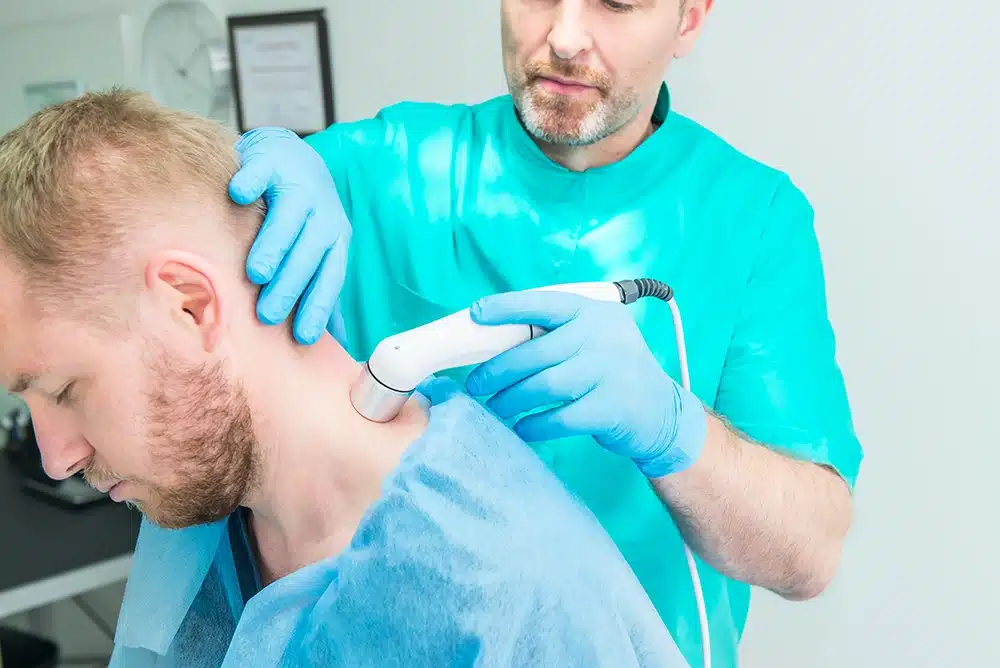
Table of Contents
ToggleNeck pain is an ailment that plagues a significant portion of the population, often leading to discomfort and hindrance in daily activities. In recent years, an innovative approach known as Low-Level Laser Therapy (LLLT), or neck pain laser treatment, has emerged as a promising solution.
This therapy, employing non-thermal laser irradiation, is gaining traction for its non-invasive nature and effectiveness. In this article, we delve into the intricacies of this treatment, exploring how it functions, its benefits, potential risks, and how it fares against other treatments.
Neck pain laser treatment, a form of LLLT, utilizes specific wavelengths of light to interact with tissues in the neck region. This technology isn’t new; it has been in use for various medical conditions, including skin treatments and pain reduction.
The treatment involves a high-frequency laser with low energy output, ensuring it’s safe and non-destructive to the tissue it targets. The principal behind LLLT is that light energy can stimulate the cells, promoting healing and providing pain relief.
This form of therapy is unique in its approach, as it doesn’t rely on heat, unlike many traditional laser treatments.

The allure of neck pain laser treatment lies in its numerous benefits. Primarily, it offers significant pain relief, both for acute and chronic neck pain scenarios.
Patients report improvements in mobility and an overall enhancement in their quality of life. Unlike some treatments that require medication or invasive procedures, LLLT stands out for its non-invasiveness and minimal side effects.
Research and clinical trials have consistently shown the effectiveness of this treatment, making it a viable option for many who suffer from neck pain.
While neck pain laser treatment is generally safe, it’s crucial to be aware of potential risks and side effects. The most common side effects are mild and include temporary discomfort at the site of application.
These side effects are significantly less severe compared to those of surgical or pharmaceutical treatments for neck pain. However, like any medical treatment, LLLT should be administered by qualified professionals, and patients should be clear about their medical history to avoid any contraindications.
When comparing neck pain laser treatment to other common treatments like medication or physical therapy, LLLT often stands out for its efficacy and minimal side effects. Medications, while effective, can have a range of side effects and, in some cases, lead to dependency.
Physical therapy is beneficial but may not be as quick in providing pain relief. LLLT offers a balance, providing effective pain relief without the risks associated with more invasive treatments.
However, it’s important to note that LLLT might not be suitable for all types of neck pain, and a healthcare professional’s advice is crucial in determining the best course of treatment.

Identifying the ideal candidates for neck pain laser treatment is crucial for its success. Generally, individuals suffering from chronic neck pain, repetitive strain injuries, or conditions like arthritis can benefit significantly from LLLT.
Age is also a consideration; while the treatment is suitable for all ages, it’s particularly beneficial for seniors who might be more susceptible to the side effects of conventional pain medication. Prior to undergoing LLLT, patients are advised to undergo a thorough medical assessment to ensure that this treatment aligns with their specific health needs and conditions.
Patients undergoing neck pain laser treatment can expect a non-intrusive and relatively comfortable experience. During the treatment, a device emitting low-level laser is applied directly to the affected area, typically for a few minutes.
Patients might feel a slight sensation at the point of contact, but generally, there is no pain involved. Post-treatment, many report immediate relief, while others observe improvements over a series of sessions.
The lack of recovery time means patients can return to their daily activities almost immediately, making LLLT a convenient option for pain management.

One of the most significant advantages of neck pain laser treatment is its effectiveness in managing chronic neck pain. Studies and patient reports have indicated that the pain relief provided by LLLT can last for weeks or even months post-treatment.
This long-term relief is particularly beneficial for those suffering from chronic conditions, where other treatments may offer only temporary respite. The cumulative effect of multiple sessions can lead to substantial improvements in pain levels and quality of life.
The medical community’s view on neck pain laser treatment is generally positive, with many professionals acknowledging its benefits and potential as a treatment modality. Research in the field continues to grow, supporting LLLT’s efficacy and safety.
While there are varying opinions and some skepticism, the overall trend in the medical field is towards embracing this innovative treatment as part of a holistic approach to managing neck pain. Health authorities and experts stress the importance of seeking treatment from qualified professionals and considering LLLT as part of a broader pain management strategy.
In conclusion, neck pain laser treatment stands as a modern, effective solution for managing neck pain. Its non-invasive nature, coupled with the minimal risks and side effects, makes it an appealing option for many.
As research continues to evolve, LLLT’s role in pain management is likely to expand, offering hope and relief to those burdened by chronic neck pain. For those considering this treatment, consulting with healthcare professionals and understanding the nuances of LLLT is essential.
As we explore and embrace these innovative treatment options, the future for pain management looks brighter and more promising.
GET IN TOUCH +
285 Sills Road
Building 5-6, Suite E
East Patchogue, NY 11772
(631) 475-5511
184 N. Belle Mead Road
East Setauket, NY 11733
(631) 675-6226
GET IN TOUCH +
285 Sills Road
Building 5-6, Suite E
East Patchogue, NY 11772
(631) 475-5511
184 N. Belle Mead Road
East Setauket, NY 11733
(631) 675-6226
SUBSCRIBE TO OUR NEWSLETTER +
Send us a Google review. Click this link and let us know how we did!
Review us on Yelp too.